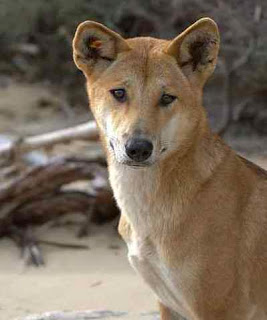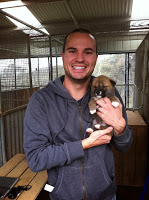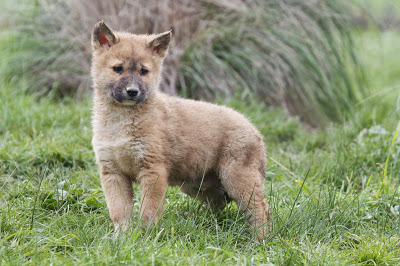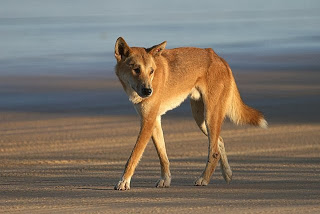Dogs
Further reading:
Smith B.P. & Litchfield C.A. (2010). Dingoes (Canis dingo) can use human social cues to locate hidden food, Animal Cognition, 13 (2) 367-376. DOI: 10.1007/s10071-009-0287-z
Smith B.P. & Litchfield C.A. Looking back at ‘looking back’: operationalising referential gaze for dingoes in an unsolvable task, Animal Cognition, DOI: 10.1007/s10071-013-0629-8
© 2013 Bradley Smith | Do You Believe in Dog?
- Science Wants To Know About The Dog In Your Bed
Guest post by: Dr Bradley Smith BPsych(Hons) PhD Hi Mia and Julie, Out of all the potential sleeping places in the house, I’m pretty sure your four-legged companion would prefer to sleep in your bed! Does yours? The decision...
- How Dogs Get The Point: What Enables Canines To Interpret Human Gestures?
Guest post by: Lucia Lazarowski, PhD candidate. Her research is available via free promotional access in the journal Behavioural Processes until February, 2016. Hi Mia and Julie, As a long-time fan of the blog, it is an honor to be a guest contributor!...
- Breed Profile: New Guinea Singing Dog
By Ruthie Bently I became aware of a newer “rare breed” of dog recently, when I was asked to write about the New Guinea Singing Dog for this blog. CANIDAE has actually been supporting several New Guinea Singing Dogs at the Tautphaus Zoo in Idaho...
- The World’s Most Amazing Dogs
Dogs are simply amazing creatures. Their loyalty is superb. Scroll down to find out if your pet dog is one of the most amazing breed of dogs in the world. These dogs still manifest traits from their ancestor – the wolf. Maremma Sheepdog is a unique...
- The Origin Of The Domesticated Dog
The domestic dog, aka Canis lupus familiaris, originated in the domestication of the gray wolf (Canis lupus). The domestication process continues even today, if we consider the fact that the cross-breeding of dogs in order to create "designer dogs"...
Dogs
Take a walk on the wild side: Dingo science
 |
| Image: Bradley Smith |
Hi Mia and Julie,
As one of the few in the world exploring the ‘mind’ of the dingo, the highly controversial wild dog of Australia, I consider myself quite a rare ‘breed’ of scientist. So I thought I would let you know about some of the recent work I have done with dingoes, including a few world first discoveries. It seems dingoes are becoming just as famous for solving problems as they are for causing them!
I find the differences between the way wild and domestic dogs think and behave fascinating.
The dingo just happens to be a great model for investigating the influence that domestication has on the canine mind because they are considered by many to be a ‘proto dog’. That is, they are thought to be one of the earliest forms of the domestic dog. Not a domestic dog as we know today, but one representing an early transition from the more-wolf-like common ancestor, to dog. What makes dingoes really interesting and unique is that they are wild living and genetically, behaviourally and physically more wolf-like than dog-like, yet are able to communicate with humans (see my paper on their ability to follow human social cues) and in the right environments, can be successful pets - whereas wolves cannot.
The dingo just happens to be a great model for investigating the influence that domestication has on the canine mind because they are considered by many to be a ‘proto dog’. That is, they are thought to be one of the earliest forms of the domestic dog. Not a domestic dog as we know today, but one representing an early transition from the more-wolf-like common ancestor, to dog. What makes dingoes really interesting and unique is that they are wild living and genetically, behaviourally and physically more wolf-like than dog-like, yet are able to communicate with humans (see my paper on their ability to follow human social cues) and in the right environments, can be successful pets - whereas wolves cannot.
 |
| Dr Bradley Smith (and dingo pup friend!) |
Domestic dogs are what we call ‘socially’ intelligent , which means they are highly adept at communicating with people. For example, they can read our behaviours, and express to us what they want. This has a lot to do with why we love them so much, why we can create such a close bond, and why they are such successful companions. But this social intelligence may have come at a cost. When faced with a problem that they cannot solve, dogs will often ‘look’ towards their owners for help instead of trying to solve it on their own. The dog’s wild counterparts - wolves and dingoes - however, have to solve problems on their own.
In problem solving situations where a human is present, wild canids rarely look back to a human for assistance, and choose to keep trying to solve the task or simply give up (for more information see my experiment on looking back behaviour).
It seems to me that humans have become tools in the dog’s problem solving ‘bag of tricks’, and the selection pressure for independent problem solving has been relaxed. It's not that dogs are lazy or dumb - they know exactly what they want, and how to get it!
In problem solving situations where a human is present, wild canids rarely look back to a human for assistance, and choose to keep trying to solve the task or simply give up (for more information see my experiment on looking back behaviour).
It seems to me that humans have become tools in the dog’s problem solving ‘bag of tricks’, and the selection pressure for independent problem solving has been relaxed. It's not that dogs are lazy or dumb - they know exactly what they want, and how to get it!
 |
| Image: Bradley Smith |
When talking about 'intelligence' in animals it is important to distinguish between different kinds of behaviour and the thinking that goes on behind them. Dogs performing fancy tricks, although impressive and fun to show your guests at parties, are learnt through operant or classical conditioning and therefore not really abilities we would consider higher-order. Perhaps the best example is tool use, which has only been reported in a select group of species. Tool-using animals are those that establish the effective orientation of an object to alter some condition and attain an incentive. This has not been reported in any canid (wild or domestic), although there are many anecdotal accounts floating around the You Tube.
So to my surprise, when I began working with dingoes at the Dingo Discovery Centre in Melbourne, Australia, and I came across a dingo that had learned to use tools! Sterling, a sub-adult male had discovered that by manipulating things in his environment, he could get up to all sorts of mischief. In one instance Sterling dragged a plastic table from one end of his enclosure to the other. By jumping on the repositioned table he was able to reach a parcel of food that was placed high on the mesh of his enclosure. Take a look:
On another occasion, I captured Sterling moving around his portable plastic kennel. He would use the kennel as a lookout to see his neighbours over the 1m high opaque wall of his enclosure. His manipulation of objects instantly remind me of Wolfgang Kohlers observations of chimpanzees stacking crates in order to reach bananas that were hanging out of reach.
Another relatively recent phenomena, considered unique to higher order creatures, are the reactions of animals to the death of conspecifics. Originally thought to only be evident in primates, it has now been documented in a variety of species such as elephants and dolphins. Similar behaviour had yet to be reported in any domestic or wild canid until an ecologist friend of mine Rob Appleby (a PhD candidate from Griffith University) spotted a dingo mother and four littermates respond rather remarkably to the death of a pup on Fraser Island (Queensland, Australia). Over multiple days, the mother transported the pup on at least four instances around the island (one of which he was able to capture on video). She did this by picking up the pup (approximately 3 months old) with her mouth and carrying it away.
To me, such behaviour is no real shock. Given that they are highly social species, have high-order cognitive ability, and live in complex societies (e.g., prolonged periods of parental care, strong mother-infant bond). Instead of making any real assertions that dingoes mourn the dead, we chose to interpret the behaviour in more evolutionary or adaptive terms. That is, that the mother was adopting a ‘wait and see’ approach to her deceased pup which still appeared physically healthy and intact. I will let you decide what you make of this behaviour!
 |
| Image: Bradley Smith |
I hope you have enjoyed reading about some of the amazing antics that dingoes have been up to recently, and also learned a few more ways why canines are so amazing! I think we have only reached the tip of the iceberg in terms of our understanding of the canine brain, and I look forward to exploring it further with you.
 |
| Image: Bradley Smith |
Bradley Smith
Senior Post-doctoral Research Fellow
Appleton Institute
Central Queensland University
@howlingdingo Central Queensland University
Further reading:
Smith B.P. & Litchfield C.A. (2010). Dingoes (Canis dingo) can use human social cues to locate hidden food, Animal Cognition, 13 (2) 367-376. DOI: 10.1007/s10071-009-0287-z
Smith B.P., Appleby R.G. & Litchfield C.A. (2012). Spontaneous tool-use: An observation of a dingo (Canis dingo) using a table to access an out-of-reach food reward, Behavioural Processes, 89 (3) 219-224. DOI: 10.1016/j.beproc.2011.11.004
Appleby R., Smith B. & Jones D. (2013). Observations of a free-ranging adult female dingo (Canis dingo) and littermates’ responses to the death of a pup, Behavioural Processes, 96 42-46. DOI: 10.1016/j.beproc.2013.02.016
Smith B.P. & Litchfield C.A. Looking back at ‘looking back’: operationalising referential gaze for dingoes in an unsolvable task, Animal Cognition, DOI: 10.1007/s10071-013-0629-8
© 2013 Bradley Smith | Do You Believe in Dog?
- Science Wants To Know About The Dog In Your Bed
Guest post by: Dr Bradley Smith BPsych(Hons) PhD Hi Mia and Julie, Out of all the potential sleeping places in the house, I’m pretty sure your four-legged companion would prefer to sleep in your bed! Does yours? The decision...
- How Dogs Get The Point: What Enables Canines To Interpret Human Gestures?
Guest post by: Lucia Lazarowski, PhD candidate. Her research is available via free promotional access in the journal Behavioural Processes until February, 2016. Hi Mia and Julie, As a long-time fan of the blog, it is an honor to be a guest contributor!...
- Breed Profile: New Guinea Singing Dog
By Ruthie Bently I became aware of a newer “rare breed” of dog recently, when I was asked to write about the New Guinea Singing Dog for this blog. CANIDAE has actually been supporting several New Guinea Singing Dogs at the Tautphaus Zoo in Idaho...
- The World’s Most Amazing Dogs
Dogs are simply amazing creatures. Their loyalty is superb. Scroll down to find out if your pet dog is one of the most amazing breed of dogs in the world. These dogs still manifest traits from their ancestor – the wolf. Maremma Sheepdog is a unique...
- The Origin Of The Domesticated Dog
The domestic dog, aka Canis lupus familiaris, originated in the domestication of the gray wolf (Canis lupus). The domestication process continues even today, if we consider the fact that the cross-breeding of dogs in order to create "designer dogs"...
